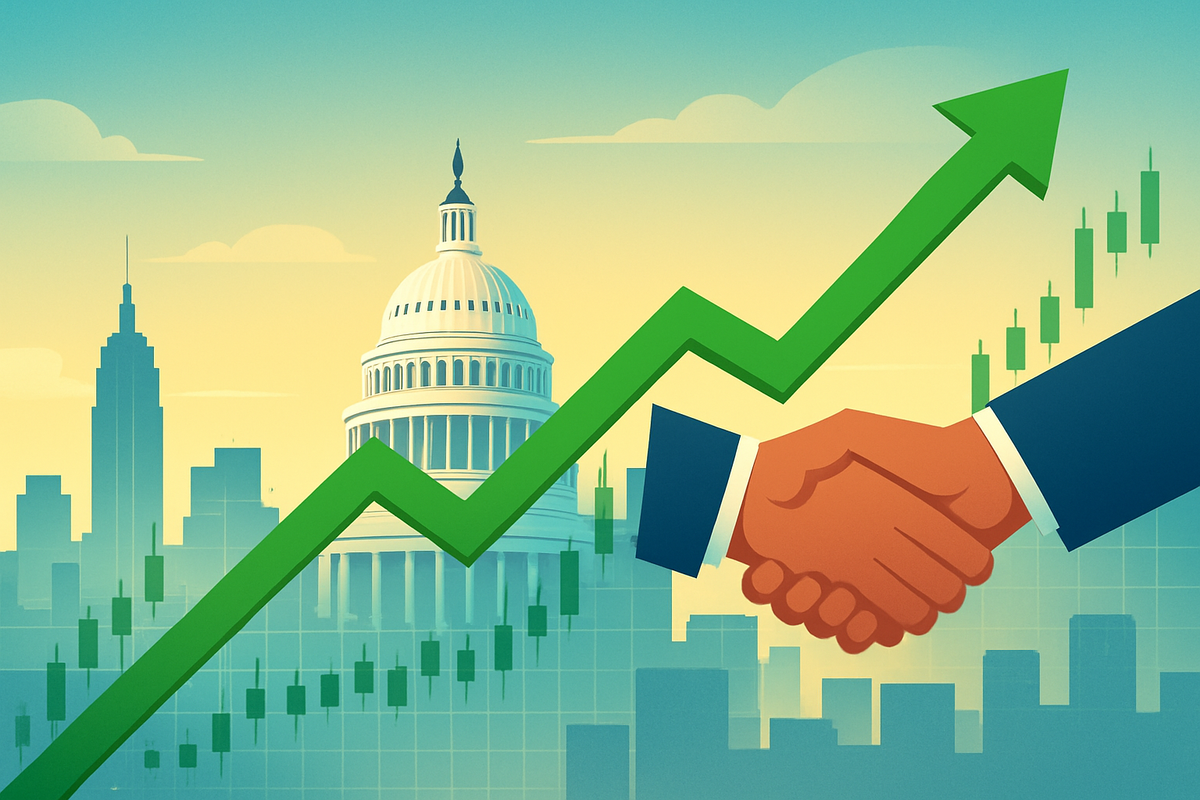
Washington D.C. & New York, NY – November 11, 2025 – The U.S. stock market is experiencing a significant "relief rally" today, November 11, 2025, as widespread optimism grows regarding an imminent resolution to a record-long government shutdown. The anticipated end to the political stalemate has dramatically boosted investor confidence, sending the Dow Jones Industrial Average (DJIA) surging and fueling a broader market rally across all major indices. This sudden shift from uncertainty to stability has been a powerful catalyst, as investors eagerly anticipate the resumption of normal government operations and the release of crucial economic data.
The positive sentiment underscores the market's strong desire for political stability. After weeks of economic uncertainty and data blackouts caused by the shutdown, the prospect of federal agencies reopening has ignited a "risk-on" mood. This renewed confidence is translating into substantial gains, reflecting the market's tendency to reward clarity and functional governance, even after periods of intense political gridlock.
Political Breakthrough Unlocks Market Confidence
The current government shutdown, which commenced around October 1, 2025, had cast a long shadow over the U.S. economy, delaying the release of vital economic indicators and dampening consumer and business sentiment. However, over the past 24-48 hours, news emerged from Capitol Hill indicating substantial progress towards a resolution. On November 10, 2025, the Senate successfully advanced a crucial funding bill aimed at reopening federal agencies, with strong indications that President Donald Trump is prepared to sign it into law, effectively ending what has been described as the longest government shutdown in U.S. history.
This breakthrough has been met with an immediate and enthusiastic response from financial markets. The Dow Jones Industrial Average (NYSEARCA: DIA) climbed approximately 0.8% on November 10th and advanced by a further 1.1% on November 11th, signaling a return to bullish territory. The positive momentum was not confined to blue-chip stocks; the broader S&P 500 (NYSEARCA: SPY) index registered gains ranging from 1% to 1.54%, while the technology-heavy Nasdaq Composite (NASDAQ: QQQ) led the charge with surges between 1.5% and 2.3%. This widespread rally indicates a significant shift in investor behavior, as capital flows back into riskier assets, including equities, commodities like oil and metals, and even cryptocurrencies such as Bitcoin.
Key players involved in this political resolution included congressional leaders from both parties, who engaged in intense negotiations, and the White House, which ultimately signaled its willingness to compromise. The timeline of events saw weeks of stalled negotiations, followed by increasing pressure from various economic sectors and the public, culminating in the recent legislative advancements. Initial market reactions have been overwhelmingly positive, reflecting a collective sigh of relief that the economic drag and uncertainty associated with the shutdown are finally coming to an end. The re-establishment of governmental functionality is expected to provide a clearer economic picture, allowing for more informed investment decisions and fostering an environment conducive to growth.
Corporate Fortunes Shift: Winners Emerge as Government Reopens
The anticipated resolution of the government shutdown is poised to trigger a significant shift in corporate fortunes, with several sectors and individual companies set to benefit from the return to normalcy. Foremost among the beneficiaries are companies heavily reliant on government contracts, which faced significant operational disruptions and payment delays during the weeks of federal agency closures. Defense contractors, aerospace giants, and technology service providers with substantial federal exposure are now breathing a collective sigh of relief as projects are expected to resume and backlogged payments are processed.
Leading defense contractors such as Lockheed Martin Corporation (NYSE: LMT), Boeing Company (NYSE: BA), Raytheon Technologies Corporation (NYSE: RTX), Northrop Grumman Corporation (NYSE: NOC), and General Dynamics Corporation (NYSE: GD) are prime examples. These companies, alongside federal IT service providers like SAIC (Science Applications International Corporation) (NYSE: SAIC), CACI International Inc (NYSE: CACI), Booz Allen Hamilton Holding Corporation (NYSE: BAH), and Leonardo DRS, Inc. (NASDAQ: DRS), can now look forward to the unfreezing of new contracts and the resumption of existing work. Even tech behemoths like Amazon.com, Inc. (NASDAQ: AMZN), through its Amazon Web Services (AWS) division, and Microsoft Corporation (NASDAQ: MSFT), which provide critical cloud and software solutions to federal agencies, stand to gain as government IT spending normalizes.
Beyond direct government contractors, companies sensitive to consumer confidence are also set for a rebound. The economic uncertainty and furloughs for federal workers during the shutdown often led to a dip in consumer spending. With the resolution, and the assurance of back pay for furloughed employees, sectors like retail, travel, and hospitality are expected to see a boost. Major retailers such as Walmart Inc. (NYSE: WMT), Target Corporation (NYSE: TGT), and The Home Depot, Inc. (NYSE: HD) could experience increased traffic and sales. Similarly, travel and hospitality giants like Marriott International, Inc. (NASDAQ: MAR), Delta Air Lines, Inc. (NYSE: DAL), American Airlines Group Inc. (NASDAQ: AAL), and even consumer staples like Starbucks Corporation (NASDAQ: SBUX) are likely to benefit as national parks reopen and travel plans, previously put on hold, are reactivated. Financial services companies also stand to advance on expectations of economic normalization and reduced systemic risk.
While the overall sentiment is positive, some entities may experience a slower recovery or face specific challenges. Small businesses, particularly those dependent on federal loans or grants, might contend with administrative backlogs that could delay their return to full operational capacity. Moreover, while large technology stocks have generally proven resilient, a broad market rally following uncertainty can sometimes trigger profit-taking in these high-performing sectors as investors rebalance their portfolios. The delay in crucial economic data from agencies like the Bureau of Labor Statistics and the Federal Reserve, though not directly impacting specific companies as "losers," created an information vacuum that clouded investment decisions. The release of this backlogged data will ultimately reduce market uncertainty, benefiting the broader market by providing a clearer economic picture, but the initial period might involve adjustments as the true state of the economy is revealed.
Broader Implications: A Return to Stability, Yet Lingering Concerns
The anticipated resolution of the government shutdown, while a cause for immediate market celebration, carries broader implications that extend beyond the immediate reopening of federal agencies. This event fits into a recurring trend of political brinkmanship that, despite eventual resolutions, can inflict real economic damage and shape long-term industry behaviors. While the immediate return to stability is crucial for investor confidence, the underlying fragilities exposed by such impasses continue to influence strategic planning across various sectors. The Congressional Budget Office (CBO) has historically estimated that even short shutdowns lead to billions in permanent economic loss, underscoring that the costs are not fully recoverable.
The ripple effects of a shutdown resolution are felt throughout interconnected networks of competitors and partners. Federal contractors, who endured payment delays and project interruptions, will now see their revenue streams normalize, potentially allowing them to catch up on deferred work and rehire furloughed staff. However, unlike federal employees, most private sector contractors do not receive back pay, meaning the financial strain experienced during the shutdown can lead to irreversible losses for some, particularly smaller businesses. Similarly, global supply chains and international trade operations, which faced bottlenecks due to curtailed export license processing by agencies like the Bureau of Industry and Security (BIS), will now find these regulatory hurdles alleviated. This restoration of governmental function is also vital for the U.S.'s international credibility, reassuring allies and foreign investors who rely on consistent U.S. policy and economic data.
From a regulatory and policy standpoint, the resolution means a clearing of the backlog of delayed rulemaking, permits, and government services. Federal agencies, which diverted significant resources to shutdown planning, can now return to full operational capacity. This could lead to a temporary surge in activity for certain regulated sectors as approvals and inspections resume. However, the recurring nature of shutdowns, often stemming from fundamental disagreements over budget allocations or specific policy riders, highlights a persistent challenge in U.S. governance. A resolution, especially if achieved through a short-term continuing resolution (CR), may only defer deeper policy debates, potentially setting the stage for future impasses and raising questions about the long-term reliability of government functions. CRs can also perpetuate inefficiencies by funding outdated programs without proper evaluation.
Historically, government shutdowns are a uniquely American phenomenon, a consequence of the constitutional requirement for congressional spending approval and the Antideficiency Act. Since 1976, the U.S. has experienced numerous shutdowns, varying in duration from days to the 35-day event in late 2018-early 2019. These events typically stem from clashes over spending priorities or ideological divides. While equity markets have historically tended to recover relatively quickly after a resolution, often within weeks, the increasing frequency of these events may lead to a long-term erosion of the predictability that markets crave. Investors, while reacting positively to the current resolution, are increasingly pricing in the expectation of continued political dysfunction, rather than viewing shutdowns as isolated incidents, which could lead to heightened volatility during future impasses.
Navigating the Path Ahead: Opportunities and Lingering Challenges
With the immediate crisis averted, the market now looks to the path ahead, which is characterized by both short-term recovery and persistent long-term challenges. In the immediate aftermath of the shutdown resolution, a period of market optimism and rebound is anticipated, as historical data suggests investors often see gains in the subsequent months. Crucial economic data, such as the U.S. jobs report and Consumer Price Index (CPI), delayed during the shutdown, will resume publication, providing much-needed clarity for Federal Reserve monetary policy decisions. Economic analyses, like those from Goldman Sachs, project a quick bounce back in GDP in the quarter following the resolution, as economic activity normalizes and backlogged work is processed. However, the current funding package, a continuing resolution through January 2026, implies that budget debates will resurface, setting the stage for potential future "almost-shutdowns" or even actual shutdowns early next year.
For businesses and investors, strategic pivots and adaptations are paramount. Companies heavily reliant on government contracts must develop more robust contingency plans, including maintaining substantial cash reserves to weather potential payment delays, and consider diversifying their revenue streams to reduce overexposure to federal funding. Investors, meanwhile, are advised to maintain a long-term focus, avoiding impulsive decisions driven by political headlines, and ensure diversified portfolios. The recurring nature of these political impasses means that monitoring political risk remains a critical component of investment strategy. Government agencies, too, must adapt by prioritizing critical functions, addressing backlogs, and developing better risk management strategies to mitigate the impact of future disruptions.
The post-shutdown environment presents a mix of market opportunities and challenges. The immediate "relief rally" offers buying opportunities, particularly in sectors like defense contracting and technology services that were directly impacted. Gold, as a safe-haven asset, may continue to see support given the underlying political uncertainty. However, challenges persist, including the lingering threat of future shutdowns, which could create recurring market volatility. The delay in economic data can complicate the Federal Reserve's ability to make timely monetary policy decisions, potentially impacting interest rates and broader market stability. Furthermore, federal contractors, especially small businesses without diverse revenue streams, face ongoing vulnerabilities due to the lack of guaranteed back pay and potential contract delays, underscoring the uneven impact of these political events.
Looking Ahead: A Cautious Optimism Amidst Lingering Political Shadows
The resolution of the 41-day government shutdown, while a cause for significant market relief, marks not an end to political volatility but rather a pause in an ongoing saga. Key takeaways from this episode include the successful passage of a continuing resolution (CR) to fund federal agencies through January 30, 2026, alongside three full-year appropriations bills. This temporary truce allowed for the reinstatement of hundreds of thousands of furloughed federal workers with retroactive pay and the resumption of vital government services and economic data releases. However, the underlying contentious issues, such as the extension of Affordable Care Act (ACA) enhanced premium tax credits, largely remain unresolved, merely deferred for future legislative battles.
Moving forward, the market's initial assessment is one of cautious optimism. Historical data suggests that while shutdowns cause immediate turbulence, the S&P 500 (NYSEARCA: SPY) has often shown resilience, with notable gains in the 12 months following their conclusion. The impending deluge of previously delayed economic reports—including crucial CPI, employment, and GDP figures—will be paramount for the Federal Reserve to make informed monetary policy decisions, potentially influencing interest rate trajectories. Sectors heavily reliant on government contracts, such as defense and specific technology services, are expected to see immediate operational normalization and a return to timely payments. However, the reliance on short-term CRs rather than comprehensive budget agreements indicates that the threat of future funding crises looms large, potentially injecting renewed volatility into the market.
The significance of this shutdown extends beyond immediate economic costs, which the CBO estimates to be billions in permanent lost economic activity. It underscores a persistent erosion of public, consumer, and business confidence in the government's ability to govern consistently. While markets often discount political noise, the increasing frequency and duration of these impasses could lead to a long-term reassessment of political risk by investors, potentially making the U.S. market less predictable. Investors should remain vigilant, closely monitoring the next funding deadline on January 30, 2026, the torrent of incoming economic data, and the Federal Reserve's subsequent policy guidance. Furthermore, corporate earnings reports will provide crucial insights into the health of individual companies and sectors, while the renewed debate over ACA subsidies will highlight ongoing political fault lines. Ultimately, while the immediate crisis is over, the lasting impact may be a heightened awareness of political dysfunction as a persistent factor in market dynamics.
This content is intended for informational purposes only and is not financial advice





